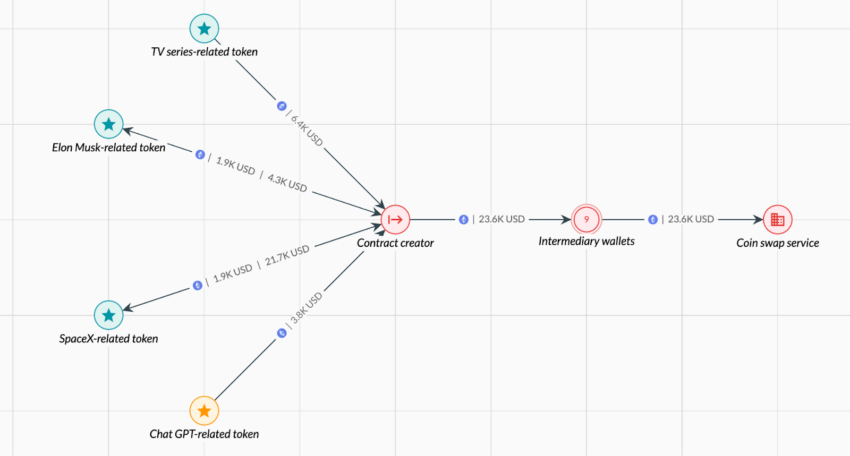Top 5 New Trends in AI-Enabled Crypto Crime: Elliptic’s Report
Blockchain analytic firm Elliptic recently released a comprehensive report titled “The State of AI-Enabled Crypto Crime: Emerging Typologies and Trends to Look Out For.” This report sheds light on the alarming rise of artificial intelligence (AI) to facilitate various crypto crimes.
While AI has been a game-changer for many industries, its misuse in crypto is becoming a significant concern.
How AI is Transforming Crypto Crime: Elliptic’s InsightsElliptic’s report identifies five core typologies of leveraging AI in crypto crimes. The first and perhaps most notorious is the use of AI-generated deepfakes. Often, scammers use fake images or videos featuring public figures to create convincing scams.
For example, fraudsters have used deepfakes of figures like Elon Musk and former Singaporean Prime Minister Lee Hsien Loong to promote fraudulent investment schemes. Scammers distribute these deepfakes on social media platforms like TikTok and X.com, duping unsuspecting investors. To combat these scams, Elliptic advises looking for specific red flags.
Read more: How Will Artificial Intelligence (AI) Transform Crypto?
“There are, fortunately, a number of red flag indicators that can help prevent you from falling victim to deepfake scams. To verify the video’s authenticity, you can check whether lip movements and voices synchronize, make sure shadows appear where you expect them to, and check that facial activity such as blinking looks natural,” Elliptic noted.
Another prevalent crime facilitated by AI is the creation of scam tokens. On many blockchains, it is relatively easy to create a new token, which scammers exploit to generate hype and artificially inflate prices before executing a “rug-pull” or a “pump-and-dump” scheme.
Tokens with names referencing AI, like “GPT,” have been particularly popular targets. Elliptic’s investigation revealed numerous exit scams involving such tokens, emphasizing the need for vigilance in token investments.
 Coin Laundering Process by ChatGPT-related Scammers. Source: Elliptic
Coin Laundering Process by ChatGPT-related Scammers. Source: Elliptic
Cybercriminals have also co-opted large language models like ChatGPT to aid their illicit activities. These AI tools can generate new code or audit existing code, which can be misused to identify and exploit vulnerabilities.
Although companies like Microsoft and OpenAI have reported malicious use by state actors from Russia and North Korea, the technology has yet to reach a point where it can consistently facilitate successful cyberattacks. Nevertheless, the emergence of unethical AI tools like HackedGPT and WormGPT on dark web forums poses a significant threat, offering services for phishing, malware creation, and hacking.
The Intersection of AI and Crypto: Opportunities and Threats UnveiledAnother area where AI is impacting is the automation of scam deployment. Some scam operations involve creating fake investments, airdrops, or giveaway sites widely promoted through social media and messaging apps.
Once exposed, these sites are abandoned, and the process starts anew with fresh sites and marketing. AI is being used to streamline this cyclical process, making it more efficient and harder to trace.
Identity theft and the creation of false documents have long been staples of the dark web. Now, some services are incorporating AI to scale their operations. For instance, one document-rendering service advertised using AI to produce high-quality fake IDs and passports.
“Elliptic has identified a crypto address used for payments to this service, which has received enough payments to generate just under 5,000 fake documents in the space of a month,” the firm added.
In January, the Commodity Futures Trading Commission (CFTC) issued a consumer alert about AI-fueled scams. The agency warned about schemes promising massive returns through crypto arbitrage algorithms and other AI-assisted technologies.
The CFTC highlighted that scammers often make false promises of quick profits, exploiting the public’s fascination with AI. One notable scam resulted in the loss of 30,000 Bitcoin (BTC), valued at approximately $1.7 billion at the time.
Read more: AI in Finance: Top 8 Artificial Intelligence Use Cases for 2024
Indeed, the intersection of AI and crypto presents both immense opportunities and significant challenges. While AI can enhance security and efficiency in crypto, its potential for misuse highlights the need for a well-planned and knowledgeable response. By understanding these new trends, stakeholders can better protect the crypto ecosystem from the evolution of criminal tactics.
The post Top 5 New Trends in AI-Enabled Crypto Crime: Elliptic’s Report appeared first on BeInCrypto.
